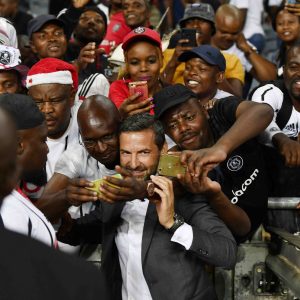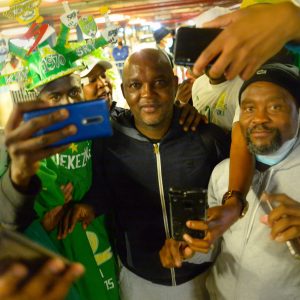Kaizer Chiefs is in need of a revival
South Africa’s most successful football team is struggling to sign the best players, playing unappetising football and have gone five seasons without a trophy. Gavin Hunt has his work cut out for h…
Author:
30 October 2020

If you were looking at the past and current season in isolation, things wouldn’t look so bad for Kaizer Chiefs. They were the painful runners-up to Patrice Motsepe’s billionaire Mamelodi Sundowns in 2019-2020, leading for almost the entire campaign but capitulating in the final half-hour.
This season, Chiefs have landed the country’s second-most successful coach of the past decade, Gavin Hunt, and in the near term trophies should follow.
Dig a little deeper, though, and all is not well in Denmark, or at Naturena. If silverware has slowed each decade from the 1990s for the one-time trophy machine of South African football, the 2010s were Amakhosi’s worst 10 years by far. They won two league titles (finishing second twice), one Telkom Knockout, one MTN8 trophy and one Nedbank Cup. Five trophies in a decade is a sorry tale for the country’s most supported glamour club.
That four of the five trophies came in the three-year tenure of one coach, Stuart Baxter, even more so. Chiefs’ 2019-2020 league failure came down to the narrowest of margins under Hunt’s predecessor, Ernst Middendorp, and more heartbreaking, in their 50th anniversary season. That Amakhosi could not create a chance after Manuel Kambala equalised in the 59th minute for Baroka FC at Bidvest Stadium on 5 September pointed to problems within the squad under the erratic-natured Middendorp. It should be seen as indicative of deeper problems at the club, too.
Related article:
The other two of the big three teams in the country have also gone half a decade without silverware. Before Pitso Mosimane arrived at Sundowns and transformed them into the most successful club of the Premier Soccer League (PSL) era, and 2016 African champions, they had gone six years without a trophy. Orlando Pirates, currently, have had far less attention directed at them for not lifting a trophy since the 2014 Nedbank Cup.
There is a reason Chiefs’ barren run is more under the spotlight. Amakhosi have set that standard for themselves. Previously they had never gone longer than a year without a trophy. Hunt’s appointment is an immediate step in the right direction, even if it seems harsh on Middendorp. Hunt has won titles and trophies with less fancied sides than the big three teams when he was at SuperSport United and Bidvest Wits.
Competing with a transfer ban
Hunt will be asked to do so at a Chiefs bizarrely frugal in the market and who this week, on Tuesday 27 October, had their appeal against a two-window transfer ban – regarding the illegal signing of Madagascan midfielder Andriamirado “Dax” Andrianarimanana in 2018 – dismissed at the Court of Arbitration for Sport in Switzerland.
If Chiefs are not to follow the same script as when Baxter departed, that of leaving behind a vacuum in success, Hunt might also want to impart his famously relentless winning mentality to a club that has increasingly lacked ambition on the field. This despite creating some of the best club facilities in Africa off the field.
The Kaizer Chiefs Village at Naturena is world class and an impressive fixed asset that should preserve their standing as the country’s biggest club for their next 50 years. But, says former Amakhosi and eSwatini national goalkeeper William “Cool Cat” Shongwe, Chiefs need to focus their attention now on the place that counts most for any football team, but especially a superclub: the field.
“They needed to be more adventurous going out to look for the players. And not just players, but players who will suit their ambition. Ambition that understands the responsibility that comes with playing for Kaizer Chiefs,” Shongwe says. “In the past, everyone used to send their players to Kaizer Chiefs. But lately, there’s a number of teams with the budget to attract the better players. And Chiefs, for some reason, have looked reluctant to splash out the money.”
Sundowns’ deep pockets under the ownership of Motsepe since 2004 have pushed up the asking price when big three teams come calling for a player. Downs have beaten Chiefs to a number of the players in which they showed an interest. Amakhosi seem reluctant to enter a bidding war as a matter of principle.
When the traffic has gone the other way down the N1 between Pretoria and Johannesburg, Chiefs have taken in Sundowns players deemed to be past their prime such as Leonardo Castro and Khama Billiat. Both forwards are showing signs of a revival under Hunt this season, though, promising a second wind.
Related article:
“They might have to revisit the approach, to not wait for players who are out of contract. Billiat was good, Castro was good, but they waited for them. And sometimes by waiting, what was good is maybe not the same,” Shongwe says.
Comparisons to Arsenal in the United Kingdom can be made. The Gunners were never the biggest team in England, but in the 1990s they rivalled Manchester United for success on the field. Huge spending on Emirates Stadium meant limited finances to spend on players. Then manager Arsene Wenger seemed to take frugality to heart, which eventually cost him his job. Arsenal, like Chiefs, have lost their way on the field.
“Something similar. But you do still feel Chiefs should compromise elsewhere to get the budget, because the biggest asset of Chiefs is the field,” Shongwe says. “If you stop getting the results, then everything else will fall apart. That’s where the supporters, the branding and everything comes from. It comes with the trophies. That’s what Chiefs was built on. And to think that Chiefs have been able to maintain the glamour so far in terms of bums in seats. It’s amazing. The brand stays. But at some stage it has to have an effect.”
With major signings not made often enough, Chiefs have relied on the same big-name leadership figures for the past decade, who have diminished in number. Bafana Bafana 2010 World Cup squad stars Itumeleng Khune and Bernard Parker remain loyal servants.
“In the past, Chiefs used to have leaders all around the field. But now you find a [Willard] Katsande, a Khune, a Parker. Maybe three or four leaders,” Shongwe says. “The promoted youngsters need to come into a structure where they can mingle with leaders and get direction. Some youngsters now come and shine above the older players. So what does that tell the youngster, that ‘I’m good’, and nothing pushes him?
“When you arrive at Chiefs, you should feel a bit lost for a few months and struggling to find your niche, struggling to make the impact. That keeps you on your toes longer, to have a longer lifespan of high performance. But if you zoom in and you’re high up there, you’re gonna drop immediately.”
No longer a force
The result has been that when Chiefs take the field, there’s not that invincible aura any more that surrounded the teams of Shongwe’s era.
Shongwe says it was a valid criticism that Sundowns and Pirates – the former with far greater success in application – have built squads aimed at achieving success on the continent, meaning that when they fall short there they still win domestically, but Chiefs have built squads aimed at domestic success so when they fall short they go trophyless.
If Chiefs are not going to break the bank, then the academy in which they have again invested heavily will have to yield better results. Shongwe says a climate exists for this, given the emergence, finally, of a reserve league in the MultiChoice Diski Challenge (MDC).
“The academy success has been a failure for most teams, not because the players are bad but it’s the bridge in a competitive stage from academy to PSL,” he says. “It’s almost impossible to adjust that player, very few can make it. You needed the MDC to fill that development gap. And now with the MDC you see a flood of players being promoted.”
It has been not only player but also coaching acquisitions that have displayed a lack of ambition by Chiefs. At the start of the 2018-2019 season, Giovanni Solinas was brought in to reverse three seasons without silverware having never won a trophy or completed a season at a club. Middendorp was a step backwards, having performed with moderate success at Chiefs from 2005 to 2007, winning his only two trophies then.
Related article:
But in Hunt’s appointment and an academy beginning to show results, there are a pair of lights at the end of the tunnel. If anyone can perform a Mosimane-like revolution, it is the 56-year-old who won three PSL titles in succession at SuperSport from 2008 to 2010, and a fourth at Wits in 2017.
Asked about his mostly friendly rival Mosimane’s unprecedented move this month from Sundowns to Africa’s Club of the 20th Century, Cairo giants Al Ahly, Hunt hinted at an awareness that Chiefs’ lack of continental ambition has been part of their demise as a domestic power. “A club our size, we’ve got to be competing on those fronts,” he said.
Hunt will draw on all his experience, from playing for Hellenic as a tough defender in the 1980s to coaching professionally in the same no-frills fashion from 1995, to negotiate the transfer ban and figure out how to balance ageing veterans with wet-behind-the ears players.
“Obviously the power has shifted a bit to up north [Pretoria],” he has said. “We’ve got to try and get ourselves back into that frame and back into that mix. The competition is getting tougher. Certainly, there are a lot more teams challenging for titles and trophies. And we certainly need to get back there, and it’s going to take a lot of hard work. The team was so close last season, 30 minutes away. And we’re going to try and get ourselves into a similar position again and see where we end up.”
Related article:
It has taken three matches for Hunt to produce a performance that, as much as Middendorp should receive credit for overachieving last season, hints at a fluidity and dynamism that has not been seen from the gold and black for perhaps a few years.
It was just one match and just a 1-0 win, but Chiefs’ DStv Premiership victory against Chippa United at Nelson Mandela Bay Stadium on 27 October – in which Hunt tried combinations fielding fringe players and they hit the post several times – was a pleasure on the eye. For a club with such traditions, the aesthetics are important.
As they anticipate the two legs of the MTN8 semifinal Soweto derby against Pirates, Amakhosi’s suffering but loyal supporters will hope the game against Chippa turns out to have been the first shots fired in the revolution.




